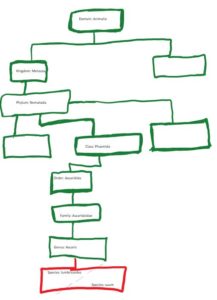
If Shakespeare is to be believed, what a rose is called is not so important, and while it makes for a poetic line it cannot be said to be true of biology (or really any scientific discipline). Names are so important there is a whole discipline dedicated to the identification and classification of all biologic organisms. This is the system of taxonomy.
Historically, identification of species was based on observation of physical attributes or/and demonstrable behaviour and infectious patterns. But, with the onset of molecular techniques we are able to re-evaluate previous conclusions on taxonomic ranks. This is particularly relevant for identifying species within a single genus.
One such case is the parasitic roundworms, the Ascaris species – A. suum and A. lumbricoides. There is a growing debate over whether they are one species or two.
Ascaris species
A. suum was first described by Goeze (1782) and A. lumbricoides in 1758 by Linnaeus. Then, identification was based on physical observations.

Both are intestinal worms which are morphologically very similar. Usually, the host that the worm is isolated from is the species identifier – A. suum infecting pigs and A. lumbricoides infecting humans. A. suum has been noted for zoonotic potential but is still considered a pig worm primarily. But, with genetic analysis being carried out on parts and whole genomes of these worms it is raising the question – is there enough distinction to warrant speciation between A. suum and A. lumbricoides?
The evidence
Based on the original observed data and on emerging genetic data, there were four theories proposed in a paper published by Daniela Leles and colleagues.
These are:
- They are distinct, valid species
- A. suum is an ancestor of A. lumbricoides originated by an allopatric event of host switching
- A. lumbricoides is an ancestor of A. suum
- A. suum and A. lumbricoides are conspecific (belong to the same species) and therefore occur as variants of a single polytypic species
There is no obvious answer
For them to be distinct species there would need to be a genetic barrier where no genetic crossover would occur. If they’re the same species, there would be full and free genetic flow. However, the current data shows a much more complex situation with some gene flow and some gene independence.
Serena Cavallero and colleagues performed a study looking at Ascaris worms from endemic and non-endemic areas and found three genotypes they called ‘As’ (A. suum banding pattern), ‘Al’ (A. lumbricoides) and ‘Ah’ (A hybrid genotype). While most ‘Al’ were from worms originating in human hosts, and ‘As’ from pigs, there were cases where the genotyped worm did not fit the expected host. Here the hybrid genotype was found in both hosts and contained both banding patterns from A. lumbricoides/suum. This does suggest some sort of gene flow occurring. The genetic genotype varied depending on whether it came from endemic or non-endemic areas (endemic having more species blurring).
The Cavallero group concluded that the presence of gene flow and the apparent absence of a genetic barrier implies the 4th assumption, as stated by Leles, is the most probable scenario in relation to this debate. These conclusions are also drawn by Leles and colleagues in another paper.
Others conclude that there are two distinct species. Anderson’s 1997 paper accounts for the genetic variation based on geography and intraspecies variation and cautions the interpretation when using single genetic markers in closely related taxa. In a previous study this team proposed that the populations of Ascaris with the same mitochondrial genotype was linked to the individual host far more than chance can account for.
Does it Matter?
So while the evidence is piling up, the answer is not (yet) proven one way or the other. Since the definition of a species is a human-created tool for convenience, it may well be that we never manage to make these two Ascaris worms fit into our neat little species box.
However, the attempt should still be made to settle this debate because Shakespeare’s line about the rose while poetic is not realistic. Aside from having a clear and accurate system that is important in terms of ensuring the robustness of the taxonomic system, it also has real life consequences for humans and for pigs, be it with a health or an economic focus.

A. lumbricoides is on the WHO Neglected Tropical Diseases list and is considered a major health concern, infecting approximately 819.0 million people, while A. suum is a burden on agriculture and economy. We have two major problems being dealt with individually when perhaps what we have is one problem that requires a joint solution. We can treat humans for ascariasis till the cows come home, or in this case, the pigs, but when they do come home, then potentially, we have re-infected humans.
We currently assume A. suum just has zoonotic capabilities, but perhaps this parasite is a bigger threat than previously thought; or perhaps not. Have we been wrongly identifying A. lumbricoides as A. suum? Knowing if it is one species that infects all, or two species that can infect humans and pigs, or two species only infecting their respective host is important. The answer will affect how we tackle the human and agricultural aspects of ascariasis.
The case of ”ascariasis – one species or two” is a wonderful jumping off point to extrapolate the question – what other species are we missing or overestimating due to incorrect taxonomy? Hopefully, the answer lies in interogating the genomes because the answers do matter for diagnostics, epidemiology, health interventions and policys.

Comments